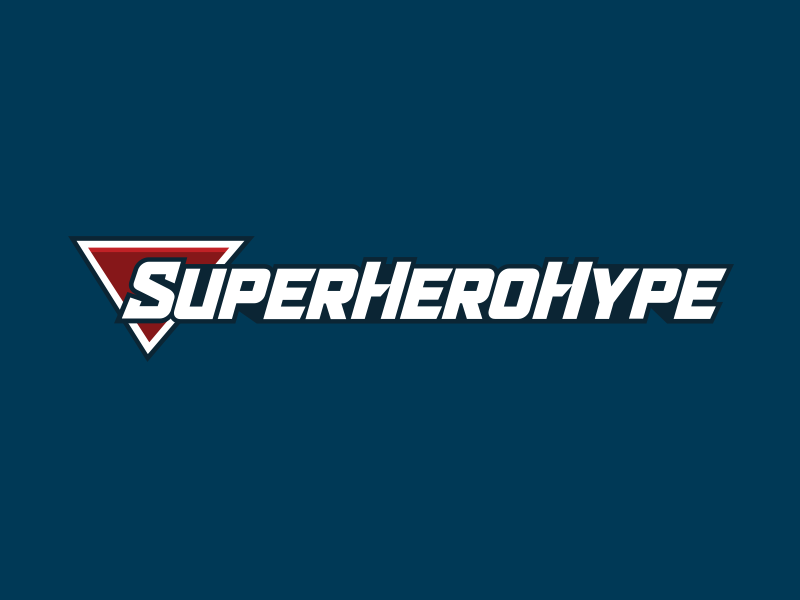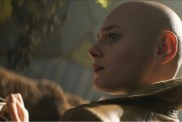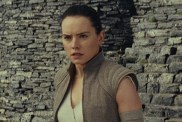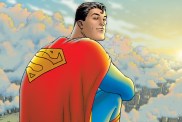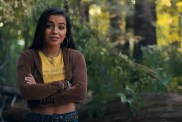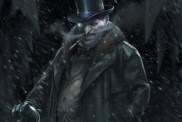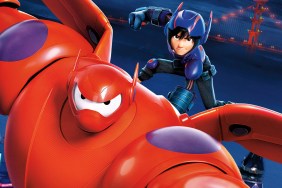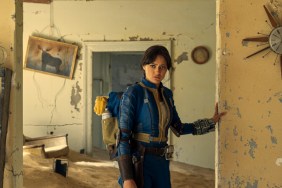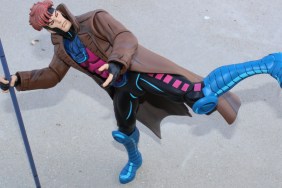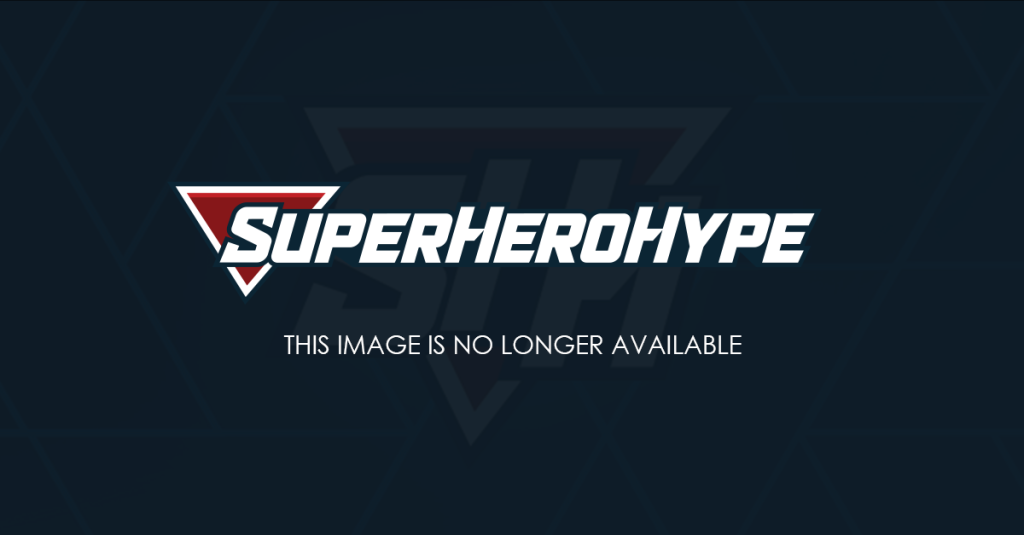
A good deal of the applause, naturally, was owed to the very special appearance of both Ryan Reynolds and Blake Lively. Reynolds, who takes center stage as Hal Jordan, an Air Force pilot turned intergalactic superhero, spoke with press in a special backstage interview following the panel. Read his thoughts below on the character, the film and the fans and check back soon for another interview with Lively.
Q: You said you weren’t too familiar with the character of Green Lantern going in. As you got familiar with Hal Jordan, what was it about him that made him stand out to you as opposed to Clark Kent or Bruce Wayne?
Ryan Reynolds: Never heard of those other guys! (laughs) But for me, it was that transformation. It was having this guy who is arrogant, cocky and reckless and could be given a higher calling and really rise to that purpose and, in that process, find it humbling. I though that was really, really interesting. That transformation that happens early on in the film is really great. This guy that really has to make the effort. He has to do something with his life in a huge way and, in turn, saves countless other people’s lives.
Q: The film relies heavily on CGI. How much pressure does that add on-set, not knowing exactly what everything is going to look like?
Reynolds: Well, it’s never good to get in a plane unless you know that you’ve got a good pilot. Part of that challenge is just having Martin Campbell. Look, I’ve got enough miles under me to be savvy about those things. To say, “Who did Warner Brothers hire? Who did they hire to do the production design? Who did they hire to do the costumes? Who did they hire to shoot the movie?” Those are all really important questions that you don’t think about when you’re starting your career. We’re in good hands. They’re spending the money on the right people to do this the right way. At some point, you’ve just got to surrender. You say, “I’m going to take care of my end of the bargain and they’re going to take care of theirs.” Then you see the end result. Or the 90% finished result, as I saw today, and you go, “Okay. They’re doing it. They’re creating that world.” It’s exciting. You hear he audience roar with applause you realize that this is what we do this for. People bitch and whine and moan on-set because it’s 180 degrees and you’re wearing a lycra costume that you’d much rather just light on fire and never see again, but you’re here. You’re seeing it in front of its core audience. It’s pretty exciting.
Q: Have you seen anything in the film that has really blown you away with what they’ve done in post?
Reynolds: I’ve been in South Africa for the past two-and-a-half months. In “Green Lantern” months, that’s like 30 years in terms of post-production. Things happen in leaps and bounds in that amount of time. I saw that a day and half ago and I just now got rid of my drool cup. The footage has just incredible. But nothing as far along as what we just saw now.
Q: So it’s sort of like seeing the film for the first time?
Reynolds: It’s all seeing it for the first time. It’s amazing. You go from a soundstage that’s four walls and a blue screen and you’re in a totally different world.
Q: This isn’t your first time playing a superhero on the big screen. Did those past works help you prepare for this one?
Reynolds: Not really. I never really played a superhero before. I was Deadpool in “Wolverine,” but I wouldn’t really classify that guy as a superhero. Years and years and years ago, I was in “Blade,” but that was as a human being as well. This is all kind of new for me. None of it really informed me. Most of it was just finding the character’s voice early on. That was always a trick. You approach it like every other film.
Q: Does it make much of a difference how thoroughly everything is scrutinized on a film like this?
Reynolds: Oh, it’s huge. I mean, I’m also a fan. I want it to be good just primarily from that level. It’s a huge weight. It buoys you in a really big way. It’s a totally different experience, seeing it with an audience that it’s designed for. Seeing it with that group of people out there was just electrifying. If it had gone the other way, it would have been a huge disaster. So it’s really great to see that they’re getting it right.

Q: You mentioned in the panel that Hal Jordan isn’t really a funny guy. Did you find that you had to suppress a big part of yourself?
Reynolds: Well, you hope so. If I’m not suppressing myself in any movie I did, things could go horribly wrong.
Q: You made a Han Solo meets Chuck Yeager reference. Is there a ratio there?
Reynolds: Well, I don’t know. This is a reference that’s mostly for me. I’m only sharing it with you guys because I’m being grilled about my process. I don’t know what the ratio is. It’s not a cake I’m baking… But any guy who wakes on a planet called Oa, you’re going to have a moment of apoplectic disbelief. You’re going to have that moment. And however it comes about or however it manifests itself organically is how it happens. So I don’t know. If you put Chuck Yeager in that situation, what would he do? Maybe the same thing. I don’t know.
Q: Can you talk about the balance of comedy with the more serious elements?
Reynolds: In terms of the overall film, I would say that Hal is far more aggressive in the movie than he is funny. Once we get in to the middle of that second act, everything is pretty serious. It’s just tough, when you’re dealing with so much exposition of an origin story, to service an audience with it in a very analytical way. It’s sort of dangerous. You have to find a way to make that entertaining and palatable. They did such a great job with doing that and allowing the movie to start in the first act instead of it starting in the third act like it does in a lot of origin stories. That will oftentimes leave an audience unsatisfied. But that’s all in there. You feel this guy’s rage and purpose halfway through the second act. That’s what drew me to the movie to begin with.
Q: How dark is it?
Reynolds: It never goes super dark or anything like that. But it has its moments. I would say that it sort of walks that tight-rope in terms of maybe “The Dark Knight” tones and some of the other recent iterations of stories from the comic book world. Tony Stark and those kind of things. It sort of walks that tight-rope somewhere in the middle of those things.
Q: There’s a lot of talk of CGI as a hindrance, but it’s interesting that it’s the story of a guy whose world is built out of willpower and imagination and the film literally does just that. Did having to imagine this world help you click into that mindset?
Reynolds: Yeah. I mean, some actors just can’t do it. They need to have that world in front of them in order to do it. But I would have felt like an ***hole asking them to build a lifesize version of Oa with an 18-story power battery in the middle of it. And there’s the budget. So you really have to embrace the make-believe and pretend. It’s really like being a kid again and actually having that power manifest itself is really pretty exciting and would be for anybody. We get to experience that through Hal. Working with a greenscreen stage for six months, you’re literally in the world of make-believe and pretend. In a typical drama movie where you have all this elements right in front of you, all you’re doing is believing. In this, you’re having to do both. You’re having to believe and you’re having to pretend. It’s like a muscle that has atrophied and once it’s back, it’s there and it’s exciting and fun. You invent things. When you invent things — when I turn my head and look at something — Martin [Campbell] doesn’t question what I’m doing. When I watch the film, suddenly the character Bzzt is cruising by. It’s so great to see that.

Q: What does Martin Campbell bring to the filmmaking process?
Reynolds: He brings an immense range of talent. He’s done serious dramas and action films and even some lighthearted stuff. He was also a shooter. He started out as a shooter, or cinematographer. You couple that with the power of Dion Beebe, who’s one of the best in the business, and you’ve really got something. But he knows what it’s like to put a knife fight in a phone booth on the screen. He’s not even here and when he’s done with the movie, he’s going to sleep for 200 years. He lives in a little dungeon and I’m sure his family is incredibly angry at him since they haven’t seen him in years.
Q: Can you talk about working with Peter Sarsgaard?
Reynolds: Peter’s great. One thing about working with Hector Hammond is that he created a sympathetic character out of what could, ostensibly, just be a villain. So we actually feel empathy for this guy who is wreaking havoc in Hal’s life. And they’re childhood friends as well, so you sort of feel a sense of loyalty for Hal and for Hector and you hope that these guys don’t come to blows. But Peter’s amazing and to see some of the work that he’s done throughout his career and onstage with us was really a privilege.
Q: This is your first 3D film. Have you seen any of the footage in 3D yet?
Reynolds: I haven’t seen anything in 3D yet, but I think that a movie like this really lends itself to being a 3D film. The constructions and the alien worlds and all the stuff on Oa really lends itself to the format.
Q: Do you know what’s going to be happened with “R.I.P.D.”? Is that going to be your next project?
Reynolds: I don’t know. I hope so. I always think that you’re not really doing a movie until you break for lunch on the fifth day. But it would be fantastic. We’re still trying to work it out with cast and crew. We’ll see.
Q: Since you never wore the suit on-set, does it only now feel like it’s paying off all the work you did, getting to see yourself on-screen?
Reynolds: Yeah, but what’s weird is that when I found out how they were doing the suit, I said, “So why do I have to be in shape? You’re putting the thing over my damned body! What am I doing, killing myself every morning?” But then I found out that they bodyscan you every two weeks. They laser-scan you. Which is something. You think, “I look pretty good!” and then you see the three-dimensional views and go, “I have work to do.” So it was kind of a weird experience to see that. But yeah, I was kind of wondering if, for the next movie, they could just use the old scans. Then I could eat human food instead of, you know, dog kibble.
Q: How does Oa and Earth balance out in the film?
Reynolds: You’re after ratios? I’d say 50/50. 50 on Earth, 50 on Oa. 50 on other stuff. My math’s terrible. I’m an actor.
Green Lantern hits theaters on June 17th in both 2D and 3D.
